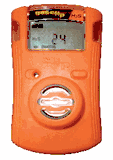- All Products
- Shop by Brands
- BW Technologies
- BW Technologies
- BW Technologies Monitors
- Models
- BW Clip
- BW Clip4
- GasAlertClip Extreme
- GasAlert Extreme
- GasAlertMicroClip XT
- GasAlertMicroClip XL
- GasAlertMicroClip X3
- GasAlertQuattro
- GasAlertMax XT II
- GasAlertMicro 5 Series
- SamplerPak
- IntelliDox Docking System
- MicroDock II
- BW Ultra
- BW Solo
- Gas Monitors
- Gas Monitor Manufacturers
- BW Technologies
- Bacharach
- Biosystems
- Crowcon
- Draeger
- Gas Clip Technologies
- GfG Instruments
- GMI/Detcon
- Honeywell Analytics
- Industrial Scientific
- IGD
- mPower
- MSA
- RAE Instruments
- RKI Instruments
- WatchGas
- Calibration Gas
- Combustion Analyzers
- Water Quality
- Reliability Instruments
- Refractometers
- HVAC
- Weather
- Temperature
- Laboratory
- Sound
- IAQ
- Electrical
- All Categories
Single-Gas Monitors
Single Gas MonitorsSingle gas monitors are uniquely suitable for monitoring, measuring, and detecting specific gases in potentially hazardous atmospheric conditions. When on the jobsite, a reliable and operational single gas monitor may mean the difference between life and death. The individual monitors are available in a wide range of gases and are suitable for most industrial applications. Many of these single gas monitors also include features that improve the operability and functionality of the device while also providing a more user friendly interface. In most single gas monitors, these user friendly interfaces are intuitive in design and utilize large glove friendly buttons that are easy to use when in the field.
Single Gas Monitor FeaturesMost single gas monitors are compact, portable, and lightweight. They are designed to be handheld personal monitors and may even have a clip. Users can then easily clip the monitor to their helmet, hat, or belt. Some monitors even feature an alligator clip, making placement easy. The single gas monitors also typically feature a multi-sensory alarm system that can notify and alert users and those nearby of potentially dangerous situations. These systems typically use audible, visual, and vibrating alarms. Please see product specifications to determine the exact alarm system for each product.
ProductsSeveral industry leaders in gas detection technologies produce and distribute single gas monitors. These companies typically have years of experience in the field and have incredible brand recognition. Some of the products include
How to Choose the Best Single Gas MonitorAs with any industrial safety solution, it is important to carefully evaluate your options before purchasing. Potential buyers should consider aspects such as pricing, warranties, features, lifespan, and reliability. Potential buyers should also compare these aspects of the product to their unique needs in their specific workplace setting. When evaluating the workplace setting, factors such as environmental hazards, sensory impairments, and personal circumstances should be evaluated. In the end, purchasers would do well to research the product, evaluate their needs, and choose a monitor that best meets those needs. For more questions about the individual products, potential users should consult the product specifications and datasheets or should contact the manufacturer for more information. |

























